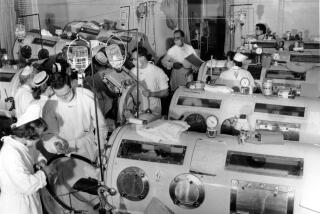Vaccinations carry worrisome side effects
- Share via
As anthrax exposures continue and the specter of smallpox has loomed on the horizon, many officials have begun discussing widespread vaccination against the two diseases in an effort to reduce public concern about terrorist threats.
But the vaccines now in use present a number of problems -- ranging from lack of manufacturing capacity to side effects -- that render large-scale vaccination programs problematic.
Medical researchers have been working on efforts to produce safer vaccines. But until now, drug companies have put relatively little money into what has been considered a low-margin, low-priority part of the business.
For anthrax and smallpox, the side effects of the vaccines are serious enough that widespread vaccination could cause more damage than the diseases themselves unless the vaccines are used only after a major outbreak has begun.
Anthrax vaccination of soldiers has produced reports of severe side effects, such as bleeding and thyroid malfunction, and has been linked to six deaths.
Just what degree of risk there is from the vaccine, however, is unclear. Many medical authorities say it is safe, but some doctors have suggested it could be one of the causes of the mysterious Gulf War syndrome, which some troops sent to the Persian Gulf in the early 1990s have said they suffer from.
Fear of the vaccine is perhaps greater than fear of anthrax. As many as 400 members of the U.S. military have been court-martialed or have resigned rather than submit to the vaccination because of the perceived risks. Some physicians share their misgivings.
“You won’t see me getting in line for the vaccine,” says Dr. Meryl Nass, a longtime critic.
The vaccine is produced by only one manufacturer, BioPort Corp. of Lansing, Mich., and the technology is nearly 40 years old. Although the company is currently producing the vaccine, the Food and Drug Administration will not allow it to be shipped because of various deficiencies in quality control and manufacturing at the plant.
The vaccine is unusual in that it is not targeted at the bacterium itself, as are most vaccines, but at the toxin produced by the bacteria as they grow. That toxin produces the cellular damage that can lead to death from an anthrax infection.
The toxin has three major components: protective antigen, lethal factor and edema factor. When the toxin is released in the body, individual molecules of the protective antigen clump together on the surface of target cells to form a doughnut-shaped pore. This pore is then used by the other two components to enter the cell, where they are lethal.
The vaccine is designed to stimulate antibodies to the protective antigen, preventing it from attaching to cells. In theory, if the action of the toxin is blocked, then the immune system can eradicate the bacteria or they can be killed with antibiotics.
“We buy the individual some time to fight off the infection,” said microbiologist Darrell Galloway of Ohio State University.
BioPort grows a strain of Bacillus anthracis that secretes only protective antigen. The bacterial culture is filtered -- in a process much like making coffee in a filter pot -- to collect the antigen along with any other materials that are secreted by the bacterium. The material that drips through the filter becomes the vaccine. It contains no bacteria, either dead or alive.
But the antigen does not stimulate a strong immune response. To get good immunity, six doses of the vaccine must be given at two-week intervals.
Critics fear that the other bacterial components collected along with the antigen may cause side effects, so research has focused on eliminating them.
“The interest is in more highly defined vaccines so one knows precisely what one is being immunized with,” Galloway said.
The Army has been working with the National Institutes of Health to use genetic-engineering techniques to produce a pure antigen. Although both the military and the NIH have consistently refused to talk about their work, other experts say that human tests will begin early next year. That vaccine will also require multiple doses.
In his research, Galloway also is targeting the toxin. But instead of using the antigen protein itself, he is injecting mice with the gene that causes the body to produce the protein. Researchers have been producing such DNA vaccines against a variety of diseases, and they are generally thought to produce a more powerful immune response and fewer side effects than standard protein vaccines.
He also uses the gene for the lethal factor in his vaccine. “We get a greater response with both than with one alone,” he said. Preliminary results in mice reported earlier this year indicate that the DNA vaccine can blunt anthrax infections, but Galloway must conduct many more tests, including vaccination of primates, before use of the vaccine in humans can be considered.
The most optimistic estimate would be 18 to 24 months before clinical trials could begin, he said.
The smallpox vaccine produces a different set of problems. Like the anthrax vaccine, it employs old technology -- dating back to experiments by Edward Jenner, the pioneer of vaccines, in 1796.
Smallpox is produced by a virus called variola, but researchers do not use it to produce the vaccine. Instead, they use a related virus called vaccinia, which produces a disease called cowpox.
The normally mild infection produced in humans by the live vaccinia provides very good protection against smallpox -- so good that the disease has been eradicated from nature. Today, variola is known to exist only in one laboratory each in the United States and Russia, although U.S. officials suspect that Iraq and perhaps other nations may also possess some virus stocks.
“The risk of its being used as a weapon is not very high, but it’s there,” said Dr. Donald A. Henderson of Johns Hopkins University, who ran the global smallpox eradication campaign. “And if you got an outbreak, it would be a terrible global catastrophe.”
Existing stocks of the smallpox vaccine were grown in calf cells, collected and freeze-dried more than 30 years ago. The vaccines are believed to still be effective, but they are contaminated with proteins and other materials from the cow cells that may produce adverse reactions in some individuals.
The FDA no longer allows vaccines to be grown in animal cells. The new contracts for vaccine production recently signed with several companies require that vaccinia be grown in human cells. That process is straightforward and should not introduce difficulties, and manufacturers assume that the new vaccine will be as effective as the old one.
“There are no technical hurdles here,” said Lance Gordon, chief executive of vaccine manufacturer VaxGen Inc. “Everything that has to be done to make a state-of-the-art smallpox vaccine is technology already in use.”
But critics caution that a smallpox vaccine grown in human cells has never been tested and that assumptions don’t always hold up.
Vaccinia, moreover, can itself produce problems ranging from open sores all over the body to death.
The death rate is estimated to be as high as 2 in a million cases, meaning that if the entire U.S. population were vaccinated, about 600 people would die of the vaccine. Inadvertent contamination of the eye -- caused perhaps by touching the vaccination site and then the eye -- can produce severe problems, including blindness.
Vaccinia itself is infectious. That’s a valuable trait in a vaccination program because it provides protection to people who weren’t directly vaccinated.
But in a modern society with large numbers of people whose immune systems have been damaged, by HIV infections or as a result of drugs taken for organ transplants, that contagion could be a major problem that likely would lead to additional deaths.
All told, vaccinating all Americans against smallpox could cause 3,000 severe adverse reactions and a much larger number of lesser problems, according to Thomas Monath, an executive at British vaccine manufacturer Acambis.
If a terrorist group actually launched a smallpox attack, however, “we don’t have any choice as a society” other than to use the vaccinia vaccine, Galloway said.
More to Read
Sign up for Essential California
The most important California stories and recommendations in your inbox every morning.
You may occasionally receive promotional content from the Los Angeles Times.










